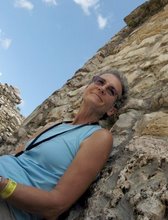
Rosa Covarrubias, (the wife of Miguel Covarrubias, a famous Mexican cartoonist and Mesoamerican art historian during the 1950's), had substantial power over Nelson Rockefeller. Because she had evidence that the Mexican government was not keeping its 50% matching commitment for the funds that Rockefeller had been putting into the Palenque excavations (field seasons 1949, 1950 and 1951), she urged Rockefeller to stop funding the project(letter dated October 9, 1951). For the two following seasons, the project, supervised by the hard-working Alberto Ruz, received no funds from Nelson Rockefeller.

However, after the historic finds that Ruz made in the Temple of the Inscriptions and after hearing one of his lectures and his plea for more funding, she wrote to Rockefeller again in March 31, 1954, where she asked Nelson to once again begin funding the Ruz excavations. On April 21, 1954, approximately 2 weeks after he received Rosa's letter, Rockefeller once again began funding the project. In addition, Rosa was part of the excavation crew for that season -- at her wish. Her description of the site is pungent and endearing, especially considering the fact that she was by profession, a dancer and actress, not at all accustomed to the hard physical labor needed at an archaeological excavation.

Dear Nelson:
Will you believe it, this is the first time I’ve seen Palenque? I can’t tell you how wonderful it is. It is probably the most impressive of all the ruins, as the jungle closes in on all sides. Tall mountains form a backdrop and the monuments face a sea of jungle as far as the eye can reach. Monkeys howl all day long and in the morning toucans and myriads of other birds play in the trees in front of the camp.
First I must thank you in the name of all the people working on this project. With the arrival of your contribution twenty people were working and the number is now 70 workers and four technicians. It is not easy to work here. The humidity is terrific, but the small Maya men seem never to tire. A beautiful river flows in front of the ruins and when work stops, they make for the river like children at play.
If you think it is easy to climb seventy steps with a sack of cement or lime, try it sometime. The ruins are in fine condition. Everything can be seen rather easily….No one knows how many there are exactly. Everybody works with caution of the dreaded Fer de lance and rattlesnake. Wasps are in every crevice.













